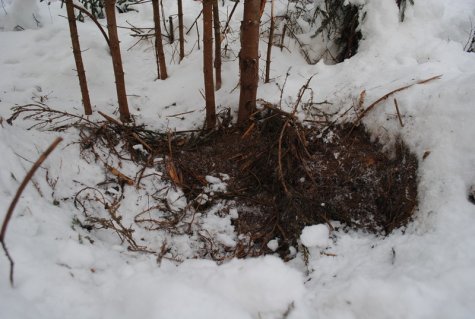Brown bear’s "winter den"
Text and photos: Bert Rähni, 360.ee
Translation:Liis
Brown bear Pruunkaru Ursus arctos
Recently some Alutaguse forest workers accidentally woke up a sleeping bear. These things happen, and luckily it wasn’t a female bear with cubs.
It was an adult male bear instead. The paw print width of 15 cm suggests a youngish male. It will probably trample around for a while and then go back to sleep again. But the natural time for bears to wake up is not far off. In the Alutaguse forests it is sometimes worthwhile to look for bear tracks from the end of March, more westwards in Estonia one or two weeks earlier. Springtime hikes in bear tracks always offer powerful experiences. Wolf and lynx prints can be confused with dog tracks, smaller predators are small, and hoofed animals „common“, but with bears every print is an experience! Clearly larger than human prints, powerful claws, never any question of whom it belongs to. Strong young birches and spruces are broken in half like pencils, on sturdier pines deep claw marks are left at some 2,5 m height, fully grown boars or elks can be slain for prey. Every metre of the hike can bring surprises.
Where do Estonian bears sleep?
Our bears don’t winter in caves or dens. The winter nest is arranged in a forest regeneration area or under the branches of a fallen tree. According to Juhan Lepasaare, well-known author of nature stories, suitable young, dense spruce stands were called bear forests in Alutaguse. There bears build a thick “mattress“ of spruce branches.
A pregnant female bear takes more trouble with the nest-building. A bear’s nest can be confused with a wild boar’s. The surest way to identify the owner is by looking for hairs. Bear hairs are brown, soft and wavy. The outer coat hairs of boars are strong, prickly and dark, the neck hairs split at the ends. A bear can have its winter sleep surprisingly near human settlements. The current nest too is only a few hundred metres away from the car road.
On the March 25 snowshoe hike in bear tracks we will look for springtime bear prints.
We will see bears, their winter dens and other tracks of activities at the Alutaguse bear safaris in May and June.











